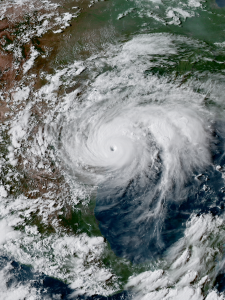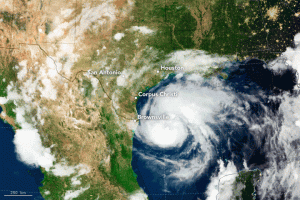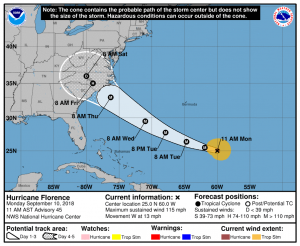June 27, 2019
Climate Change Threatens to Produce More Intense Hurricanes. Federal Funding Must Keep Up
Posted by Caitlin Bergstrom
Henry Potter earned a BS in geography at Indiana University in Bloomington, Indiana and a PhD in applied marine physics at the University of Miami in Florida. He completed a postdoc at the Naval Research Laboratory Remote Sensing Division in Washington, DC and became an assistant professor of oceanography at Texas A&M University in 2016. Henry focuses his research on the marine boundary layer in order to better understand air-sea exchange of heat, mass, and momentum. He has a particular interest in the unique nature of these exchanges in hurricanes and other high wind speed environments.
Imagine a major hurricane is approaching the Gulf of Mexico. You turn on your television and a meteorologist is discussing where the storm is likely to go and how intense it will be. A long, curving white cone, marking times and wind speeds, is projected onto a map of the Gulf and the Southeastern United States. While this image will be familiar to most Americans, many probably aren’t thinking about—or are even aware of—the science that goes into predicting where hurricanes go, much less how that science is even paid for. The vast majority of funding for hurricane research comes from the federal government. And as climate change threatens to produce more intense storms, putting as many as 126 million people living in coastal communities at risk, it’s increasingly crucial that funding for hurricane research is protected.
Fast winds and flooding resulting from storm surge and extensive rainfall make hurricanes some of the most costly and deadly natural disasters in the U.S. Hurricane Harvey alone caused 89 deaths and $129 billion in damages (NDBC) when it hit the Texas coast in August 2017 and dumped 60 inches of rain on Houston. These death tolls and damages are second only to Hurricane Katrina. Hurricanes are not only costly, but relatively common. Between when record-keeping began 1851 and 2017 approximately two hurricanes have made landfall in the U.S. each year on average. Of these, one out of every three was considered major, a category three or greater. To reduce the loss of life and financial burden of hurricanes, forecasts must be accurate. A great deal of progress has been made with hurricane track forecasts and, to a lesser extent, intensity forecasts (DeMaria, 2014) but there remains room for improvement.
High wind speeds in hurricanes occur because of the pressure difference between the center and the edges of the storm. Air from the higher pressure edges rushes inward to the very low pressure storm center, while the Coriolis force creates a rotating system. Energy from the wind is transferred into the ocean generating powerful currents which mix the ocean, and large breaking waves which blanket the surface with whitecaps and fill the air with spray. All these factors impact hurricane intensity and are important for forecasting. This unique and extremely turbulent environment, which doesn’t exist at lower wind speeds, is very challenging to study because of the harsh conditions. Consequently, much remains unknown about the mechanics within hurricanes above and below the water surface that influence their intensity and path.
The ultimate goal of hurricane research is to provide increasingly accurate and reliable forecasts. This work is particularly important in light of our changing climate which is increasing global ocean temperatures (Zanna et al., 2019) giving rise to the threat of more intense hurricanes (Knutson et al., 2010). Through the National Oceanic and Atmospheric Administration (NOAA), the National Science Foundation (NSF) and the National Aeronautics and Space Administration (NASA), the federal government leads the way in funding hurricane research. Among many grants awarded yearly, NSF funds basic hurricane and high wind speed science as well as rapid response research which can be used for scientists to quickly mobilize and study hurricanes as they happen or their immediately afterward (e.g., Potter et al., 2019). NOAA and NASA both maintain sensors that continuously monitor the ocean and atmosphere providing data that are essential to any hurricane research toolkit. NOAA’s global array of ocean buoys provide near real-time and historical environmental data such as wave height, wind speed, air and water temperature, and atmospheric pressure, offering an intimate look inside passing hurricanes (e.g., Wang et al., 2015). NASA’s family of earth-facing satellite measurements include ocean winds, sea surface temperature, and ocean surface topography (JPL) over large areas and can be used to understand the impact of hurricanes on the ocean through the air-sea exchange and redistribution of energy.
NOAA’s Climate Prediction Center outlook for the 2019 hurricane season, which began June 1st, predicts between 9 and 15 named Atlantic storms and 4 to 8 hurricanes, of which 2 to 4 are expected to be major (NOAA). Competition for non-defense discretionary spending is fierce, and climate change science has become a politically polarized issue. As coastal residents continue to increase in number and the warming ocean creates increasingly powerful hurricanes, now more than ever it is essential that agencies such as NASA, NOAA, and NSF get adequate federal funds to continue to support hurricane research.
References:
DeMaria, M., Sampson, C. R., Knaff, J. A., & Musgrave, K. D. (2014). Is tropical cyclone intensity guidance improving? Bulletin of the American Meteorological Society, 95(3), 387–398. https://doi.org/10.1175/BAMS‐D‐12‐00240.1
JPL. https://www.jpl.nasa.gov/missions/surface-water-and-ocean-topography-swot/
Knutson, T. R., McBride, J. L., Chan, J., Emanuel, K., Holland, G., Landsea, C., … & Sugi, M. (2010). Tropical cyclones and climate change. Nature geoscience, 3(3), 157.
NDBC https://www.ncdc.noaa.gov/billions/events/US/2017
NOAA https://www.cpc.ncep.noaa.gov/products/outlooks/hurricane.shtml
Potter, H., DiMarco, S. F., & Knap, A. H. Tropical Cyclone Heat Potential and the Rapid Intensification of Hurricane Harvey in the Texas Bight. Journal of Geophysical Research: Oceans.
Wang, D. W., Mitchell, D. A., Teague, W. J., Jarosz, E., & Hulbert, M. S. (2005). Extreme waves under hurricane Ivan. Science, 309(5736), 896-896.
Zanna, L., Khatiwala, S., Gregory, J. M., Ison, J., & Heimbach, P. (2019). Global reconstruction of historical ocean heat storage and transport. Proceedings of the National Academy of Sciences, 116(4), 1126-1131.




